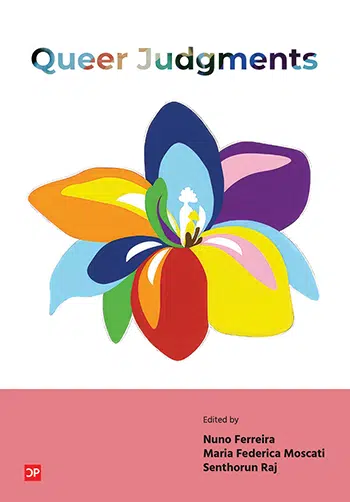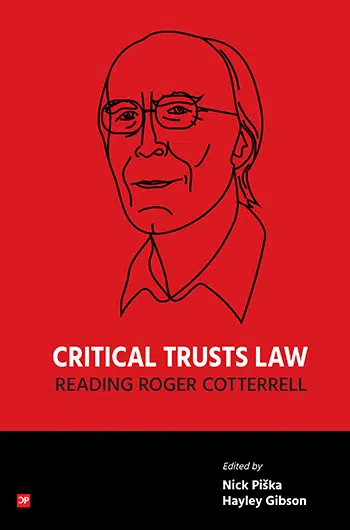
The politics of aesthetics are at the heart of Rob Knox and Christine Schwöbel-Patel’s energetic edited collection Aesthetics and Counter-Aesthetics of International Justice brings together a diverse group of scholars, practitioners, and artists. The editors approach the aesthetics of international justice in terms of tactics that can be deployed for good and ill.
Essays in the first half of the collection interrogate hegemonic tactics. The anaesthetising, romanticising, distracting, and otherwise legitimising use of aesthetic objects in service of the status quo and the even worse. Contributions in the second half consider and enact counter-aesthetics, which “shift[] the dominant gaze or frame” (144) and “tak[e] the side of the downtrodden” (151). As well as essays, counter-aesthetic contributions include poems, parables, and graphic narratives, which the editors read through three counter-aesthetic tactics: rupture, détournement, and solidarity aesthetics. None of these forms is proof against recuperation by the powers that be because the politics of aesthetics are a product of tactical instrumentalization for hegemonic or emancipatory purposes (153-4).
This contribution reflects on a recent aesthetic intervention in the politics of colonial history by the British-Guyanese sculptor Hew Locke (b. 1959). His exhibition, What Have We Here?, ran at British Museum last winter, occupying the eerie above the old library in the BM’s gleaming conservatory. I visited the exhibition in December with a group of undergraduate law students on an art/law module I run at Queen Mary University of London. The module sets out to plant seeds of critical thinking by helping students learn to look at visual artworks. The premise of the module is that the artworks best fitted to this task are not the ones whose politics can be most readily pinned to a particular context (though admittedly many students are drawn to works of propaganda and censorship) but the ones which force the viewer into critical attitudes like self-reflection, situational awareness, tolerance of irresolution, doubt, and curiosity.
What Have We Here? did all these things. The exhibition was a critical collaboration with the BM, an institution repeatedly exposed and shamed for complicity in colonial exploitation, imperial aggrandisement, and its continuing refusal to return looted objects. Locke is far from naïve about the ways brutish museums pay lip service to such criticisms in hopes of neutralizing them. Public statements about contested objects in the collection explain that the institution “cares for important objects” taken during colonial exploits. Likewise, rewritten object labels acknowledge the problematic provenance of many of the objects in the collection as though recognition alone makes good the wrong. The detached, older-sibling tone of such attempts to set the record straight are worlds away from the counter-aesthetic of What Have We Here? which invited visitors into a space of sense-making that could be simultaneously collaborative and personal.
Entering the exhibition space in medias res, my students hesitated. It was unclear which way they should turn and where they should start. Eye-catching exhibits sparkled, loomed, and otherwise beckoned their attention on all sides and no official sequence was explicitly given or otherwise evident. Gradually, they dispersed in pairs and small groups to make their own ways around the exhibition. This was just as Locke intended. In an interview with Artforum magazine, he explained that he wanted viewers to meander through the exhibition in the way history meanders rather than progresses in a linear fashion, “causing us to visit and revisit many of the same lessons”. Displays spanning multiple centuries and continents suggest that colonisers learned little from often repeated lessons, a lack of progress evident in repeating patterns palpable in the exhibition space.
Four broad themes of Sovereigns, Trade, Conflict, and Treasure bled into one another and, on the ground, visitors crossed and recrossed thematic boundaries unawares. Locke wanted us to trace histories for ourselves as we moved around the exhibition, drawing connections, shuttling backwards and forwards in time, vaulting across continents. The non-linearity of Locke’s history-telling is mirrored in the circularity of the exhibition. We left the exhibition where we entered, passing an Asante goldweight in the shape of a Sankofa bird. The mythical bird ‘reminds the observer not to be afraid to try to redeem mistakes already committed in the past’. This is not about wiping the slate clean and setting the museum’s (and visitor’s) conscience at rest. Locke said, “I’m trying to bend the past and the present together”. This simultaneity lies in the viewer’s encounter with the objects on display.
What Have We Here? was an exercise in aesthetic sense-making – as much creative and affective as it is cognitive and rational. Objects in the exhibition wrong-foot us – especially ones from Locke’s oeuvre. Intricate and sparkling, works in his Souvenir series, for instance, beguile the eye from a distance only to expose the viewer as a dupe gulled by fake pearls, military medals, and plastic snakes used to gussy up souvenir Parian ware busts of British royals bought by visitors to the Great Exhibitions of 1851 and 1862. According to Locke, ‘these national figureheads are weighed down by the burden of British history’. Primed by this false majesty, we look differently at the glitz and glamour of the real deal. Franz Winterhaler’s 1856 portrait of Queen Victoria wearing the Koh-i-Noor diamond, for instance, is encountered as an object heavy with dispossession (Duleep Singh’s) and guilt (Victoria’s). One of my students wrote a fierce, piercing essay about it, taking Locke’s cue to follow skeins of connection and laying burden upon burden onto the portrait.
Many of the students who visited the exhibition were inspired to write about the visit in their coursework essays. Some of them were stymied by its resistance to official accounts and expert knowledge. The histories Locke tells are not monolithic and are not delivered in the passive voice of objective disinterest that law students are often encouraged to emulate. The resulting essay struggled to modulate between a scholarly tone and Locke’s determinedly unacademic tone, which permeated the exhibition both in unconventional object labels and through a piped voiceover.
Exhibition visitors were not expected to act like connoisseurs or historians. Locke’s voice offered other ways of looking at the objects he assembled. For instance, a note next to carved cattle horns from the Anglo-Zulu war invokes the 1964 film Zulu, which “depicts their battle formation in the shape of horns against the Red Coats”. Locke reminds viewers that the film was a Christmas staple of 1980s Britain, a reference lost on my undergrads, but which nevertheless provoked whispered mentions of the museum heist scene in the 2018 film Black Panther. Instead of reproducing Locke’s view, my students took Locke’s sideways object label as an invitation to look sideways for themselves.
The non-expert tone of the exhibition commentary was freeing. It removed the pressure to engage in identity thinking, where the only way to look at aesthetic objects is to match them with their proper stylistic, technical, and historical meanings. Locke made it possible to react with disgust, confusion, disappointment, and mirth. In the text accompanying a drawing by Augustus Earle, ‘Slave Market in Rio Janeiro’, Locke notices the documentary style of the work: “It’s what’s both interesting about it, and truly horrible about it – it’s so very casual. It’s just a casual, everyday slave market scene”. Refraining from loading the viewer down with contextual information about Earle, print-making, or slave trading, Locke models the kind of emancipated spectatorship championed by Jacques Rancière, whose ideas about the distribution of the sensible Knox and Schwöbel-Patel draw upon (5-6).
For Rancière, it is the aesthetic regime of modernist art that leaves the viewer most space to look freely. In Locke’s exhibition – as in Gerry Simpson’s chapter in Aesthetics of International Justice – humour helps the viewer to get out from under the weight of historical knowledge. Some of Locke’s commentary is very funny as he slides a side-eye at colonial artists and adventurers. European artists, Locke observes, ‘had a computer chip wired into their brain, where you cannot just depict a view – it had to be an idyllic, classical landscape’. Elsewhere, the improbably named colonial adventurer Captain Tristram Speedy (1836-1910), responsible for many of the looted objects and photographs in the Museum’s collection, is sent up as a pantomime swashbuckler. In cocking a snook at these figures Locke offers a way of confronting and living with painful and shameful histories.
That What Have We Here? enrolled the museum visitor into its political project of sense-making was most apparent in a new work Locke made especially for the exhibition. My students and I did not notice at first, but we were being watched. Watchers looked down on us from above, posed as though conducting their own conversation about the exhibition and its visitors. The figures seemed to be judging us, but how and in what register was impossible to tell. Facial expressions were hard to read and, in most cases, obscured by masks, helmets, and headdresses. Ornate costumes made the figures even stranger and hard to read. They couldn’t have looked less like the uniformed museum staff who usually keep an eye on things.
Many of the costumes use fabric printed with images from Locke’s Share series, several works from which are also on display in the exhibition proper. For instance, we see the corner of a skull painted directly onto a share certificate from a Tobagoian cocoa plantation. Exhibition text explained that Locke saw in the certificates an attempt ‘to project an image in the detail of the decoration, to make them look like you’re investing in something stable. But they are also instruments of control’. Locke subverts this attempt to control in works like ‘Chinese Imperial Gold Loan 11‘ (2017), which imposes a pastel coloured, jigsaw-puzzled African continent over most of the certificate text, reappropriating the share certificate as a canvas and détourning its ornamentation for the purposes of critique. Made up of exhibition material, the Watchers are phantasmagorical emanations of the objects on display. They worked to mediate the encounter between visitor and object, making us conscious of ourselves as viewers.
The Watchers felt like a judgmental presence – they were not guardian angels there to protect the viewer. Once noticed, you couldn’t shake the feeling of being observed – especially as the figures pop up unexpectedly outside the exhibition space, making surprise appearances in the museum’s Enlightenment gallery, for instance. They remind us, of course, that we viewers are also on display and subject to judgment. We get no brownie points merely by virtue of our presence at an exhibition about colonialism, just as the museum cannot disavow its complicity merely by acknowledging it.
If Locke doesn’t let us or the museum off the hook, he doesn’t spare himself either: ‘They’re judging us like a kind of Greek chorus, and they’re judging me’. He doesn’t stand outside the exhibition but puts his own complicity on the line by displaying his OBE and Royal Academy medal. ‘Even though I’m critiquing empire, I’m a part of it as well’, he told Artforum. Not only does Locke abandon the moral high ground, he also disappears the hierarchy between artist and audience. Visual artwork is a kind of looking; viewers are part of a creative collaboration in sense-making. We see this confluence also in the hybrid contributions to the edited collection in which critique and creativity mingle, notably in Sofia Stolk’s reverse-engineered screenplay for an International Criminal Court public information film and in Gerry Simpson’s parables on Adolf Eichmann. Hard to characterise as forms, both contributions hover are simultaneously second-order critiques and creative acts.
As Guy Debord noticed – and Schwöbel-Patel and Knox cite (8) – the politics of aesthetics are rotten when audiences are reduced to consumers. The aesthetic intervention enacted by What Have We Here? cannot be reduced to political messaging. Viewing the exhibition is an active practice in which the viewer joins the artist in creative, collaborative, contingent sense-making.
2nd May 2025
Isobel Roele (i.roele@qmul.ac.uk)
School of Law, Queen Mary University of London





0 Comments